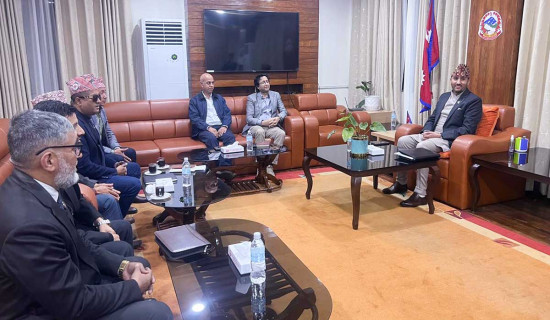- Wednesday, 17 December 2025
Follow Weather Forecasts
Parmeshwar Devkota
In the past, when there was not advanced forecasting technology, meteorologists had found it difficult to make accurate forecasting. They were accused of predicting weather just by throwing a glance at sky. There were cases in which the meteorological officers forecasted that there were chances of heavy rainfalls but the day turned out to be sunny. This made the people laugh at the weather forecasters. But now, things have changed for good. The Department of the Meteorology and Hydrology has been well-equipped, forecasters have been well-trained, enabling them to predict accurate forecasting.
If the state mechanisms had enforced the weather forecast last week and the transport entrepreneurs had been prevented from plying their vehicles during the said period, the nation would not have suffered such a huge loss of lives and property on the eve of great festival Dashain. At the end of this year’s monsoon season, more than two hundred fifteen have lost their lives, over a dozen people are still missing in rain-triggered floods and landslides, especially, in the central part of the country. The settlements of some places are still facing the risk of landslip. Thousands of people have become homeless.
The transport entrepreneurs have lost hundreds of vehicles while thousands of hectares of fertile lands have turned into barren land. Farmers have lost paddy worth billions of rupees. The major highways are not fully operational due to unanticipated destructions and the risks are still persisting in some part of the country, because the monsoon is yet to withdraw. Negligence on the part of the citizens is equally responsible because they ignore cautions issued by the Department of the Meteorology and Hydrology. Now its weather prediction is accurate or near accurate.
Our land, hills and mountains are fragile. The formation of Chure, Mahabharata and Himalayas is considered the youngest one. Its formation began some 40 to 50 million years due to the collision of Eurasian and Indo-Australian tectonic plates and the process of forming mountains is on, because this region’s altitude is increasing at a rate of 3 to 4 millimeters per year. As this part of land is tectonically active, our mountain rocks absorb rain and flood waters and become vulnerable to landsides. Therefore, landslides are common in this region due to the topography. Due to the push and pull of the tectonic plates, small and large quakes are rattling region frequently.
Bearing this vulnerable geological situation in the mind, the state established hydrological and meteorological monitoring system in 1962 AD under the Department of Electricity. The system was transferred to the Department of Irrigation and was renamed as the Hydrological and Meteorological Department (HMD) in 1988. Now, HMD is under the Ministry of Water Resources and Energy. It is the member of the World Meteorological Organisation and shares meteorological data at the global level. The HMD shares data from Indian, Chinese and Japanese satellites on weather change and other natural calamities.
Therefore, the data obtained by the HMD on water resources, agriculture, energy and other areas of development sectors are authentic. The forecasts related to rains is highly useful for public, mountaineering expedition, civil aviation, and the mitigation of natural disasters. The government apparatuses should follow suggestions of the HMD. The entrepreneurs, farmers and travelers must consider the HMD's warning so that they will not suffer from the natural calamities.

















